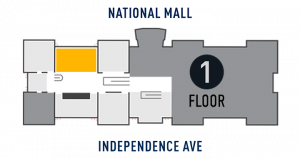Pratt & whitney developed the 4,500-kilogram (10,000-pound) thrust JT3 turbojet engine in 1950. It powered such military aircraft as the Boeing B-52, Convair F-102, Douglas A3D, Lockheed U-2, McDonnell F-101, and North American F-100, and a majority of Boeing 707 and Douglas DC-8 transports. The prototype Boeing 707 (367-80), now in the collection of the National Air and Space Museum, was powered by the JT3 engine.
When modified to the JT3D turbofan configuration, this engine powered the same transports with greater fuel efficiency, more thrust, and less noise. The modification included replacing the first three compressor stages with two fan stages, which extend beyond the compressor casing and act like propellers. The resulting increase in air flow is beneficial at speeds between 560 and 1,045 kilometers (350 to 650 miles) per hour.
Display Status
This object is on display in America by Air at the National Air and Space Museum in Washington, DC.

Object Details
Country of Origin
United States of America
Type
MODELS-Propulsion
Manufacturer
Pratt & Whitney
Physical Description
This is an operating, 1/4-scale model of a Pratt and Whitney JT3C (military designation J57) turbojet engine; the model is in a display case with a label.
Approximate Engine Length 88 cm (34 in.), Diameter 25 cm (9.7 in.), Weight 176 kg (388 lb); In case (84 in.x 48 in. x 40 in.) w aircraft models
Dimensions
3-D: 117.5 × 25cm (46 1/4 × 9 13/16 in.)
Overall: 86.4 × 24.6cm, 176kg (2 ft. 10 in. × 9 11/16 in., 388lb.)
Materials
HAZMAT: Cadmium
Aluminum
Plastic
Paint
Ferrous Alloy
Ink
Inventory Number
A19660009000
Credit Line
Gift of Pratt & Whitney Aircraft Division, United Technologies Corporation, No known restrictions.
Data Source
National Air and Space Museum
Restrictions & Rights
Usage conditions apply
For more information, visit the Smithsonian’s Terms of Use.